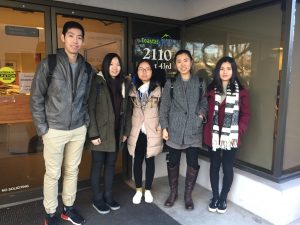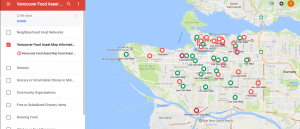Hi, welcome to our blog!
First, we’d like to introduce ourselves.

Stephani Fan: A third-year student in Food, Nutrition and Health program; interests: photography and hiking.
Imogen Li: A third-year student in Food, Nutrition and Health program; interests: cooking and yoga.
Irene Cao: A third-year student in Nutritional Sciences program; interest: reading novels.
Renee Huang: A third-year student in Food, Nutrition and Health program; interest: playing badminton.
Travis Lam: A third-year student in Food Market Analysis program; interest: playing basketball.
Manessa Man: A third-year student in Food Market Analysis Program; interests: traveling to experience different cultures and food, and baking.
The project: Vancouver Food Asset Map – Multi-Language How-to Video
If you ask me to use one word to describe Vancouver, “diversity” would be the first one that comes to my mind. Food is diverse in Vancouver. It is not so hard to find burritos, sushi and grilled steak on the same street. So are the languages. If you get on a bus, you can always hear someone speaking in a language other than English. Unfortunately, the diversity also reflects in living conditions. Some people enjoy nutritious meals every day, while some people constantly struggle with food insecurities.
We are a group of people who are passionate about food as well as food justice and food securities. Through the course LFS350, it is very fortunate for us to pair up with the dietitians from Vancouver Coastal Health to make a short how-to video for Vancouver Food Asset Map. Vancouver Food Asset Map is a useful tool which helps people living in Vancouver find food assets in their communities. Considering that Chinese makes up a big portion of Vancouver population, we are going to make a video in Mandarin as well.

Objectives
- We would like to learn from the dietitians how to plan and carry out a large-scale project.
- It is also very important for us to reach out to communities so that we can better understand the disadvantages and advantages of Vancouver system. We strongly agree with the concept of asset-based community development. Instead of posing ourselves as experts, we want to be listeners and servers in the community (Mathie & Cunningham, 2003). People in the community eat and have to eat. They already know a lot of ways to find food assets so we can learn from their successful experience and perfect the map.
- Through the process of interacting with dietitians and our community partners, we hope that the videos we make will provide food access for more people, especially who are Chinese from low-income families and having difficulty understanding English.
- Introduce the concept of Vancouver Food Asset Map to the public and educate people how to utilize it.
- Improve and update the Vancouver Food Asset Map constantly.
First Impressions
During this Tuesday, we had our first meeting with the dietitians Teya Stephens and Kathy Romes, from the Vancouver Coastal Health. They introduced us to the project of Vancouver Food Asset Map and would provide support throughout the process of the project. We all feel confident and excited, and can’t wait to start this project. In addition, the video that we make will be released in the community. As Ernesto Sirolli mentioned in the video, “sit[ing] with the local people” is the best way to target the key problem and improve the project because no one better than the community members themselves know what their real struggles are (Sirolli, 2012). By gathering their responses, we can know what difficulties they have on obtaining food assets or understanding the video. It enables us to improve the video to suite their needs. At the end, as parts of the Vancouver communities, the main goal that we participate in that project is that people can learn more about the Food Asset Map and utilize it in the daily life to promote a healthy eating lifestyle.
References:
Mathie, A., & Cunningham, G. (2003). From clients to citizens: Asset-based community development as a strategy for community-driven development. Development in Practice, 13(5), 474-486. doi:10.1080/0961452032000125857
Sirolli, E. (2012, September). Want to help someone? Shut up and listen! Speech presented at Ted Talk. Retrieved January 25, 2017.
